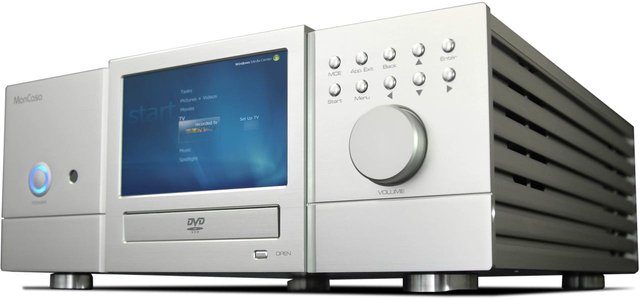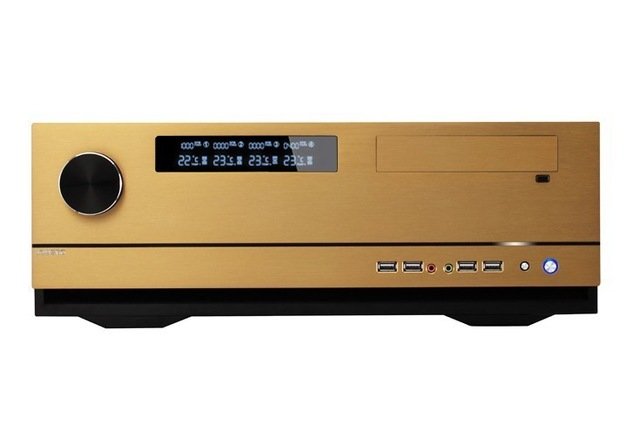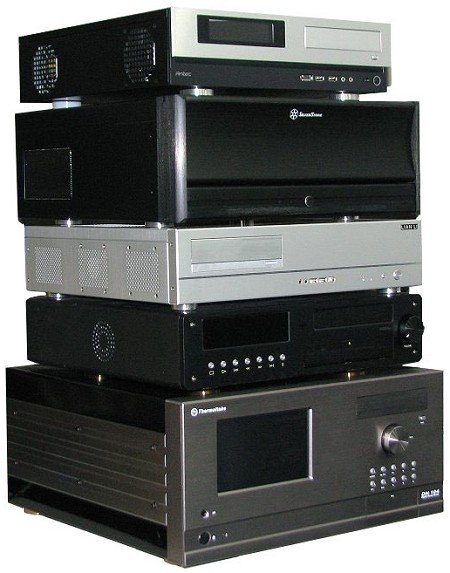Home Theater PC building by the numbers- step 1
One of the first steps in building a HTPC (Home theater PC) is deciding on the case.
There are many HTPC cases available, your decision will on the one hand depend on your personal taste and on the other hand on what you are going to be using your HTPC for. A rig for gaming will need room for a video card and a HTPC that you will be using for watching Blu-ray movies will need a drive bay at the front.

The form factor
This is a specification of the dimensions of the motherboard, the most used forms are ATX, micro-ATX, mini-ATX, micro-ATX and nano-ATX. When choosing a case always check which form factors the case supports. Keep in mind that you will need a motherboard with a form factor that is supported by your case.
If you are planning to do some serious gaming you have to take the height of the case into consideration. You will need room if you are going to add a video card, also make sure if it is possible to use two video cards in a SLI or Crossfire configuration.
My advise is to always go for an option where you are able to add a video card. This way you can keep your options open and you won't have to buy a new case if you decide to add a video card later on
The shape
The shape will depend on your personal taste. HTPC's come in all kinds of different shapes and sizes. Basically you can use any type of case you want, even the classic tower. But if you are planning to place your HTCP in your living room in plain site, it is best to search for a case that has some nice appeal. My personal favorites are the desktop cases that resemble an A/V receiver.
Airflow
The importance of airflow is often underestimated. Whether you are planning to put your HTPC in a cabinet or on a desk, you must make sure that the case has a good airflow. On the one hand so that the Case and its components are cooled sufficiently and on the other hand to make sure that your HTPC is as silent as possible. Make sure that your Case has a good air-flow system with sufficient options to place your cooling fans.

Casefans
Usually PC cases come with a minimum of cooling fans. If you have the option to add more fans, go for it! My advice to use premium fans like Noctua or Scythe instead of the stock fans. The premium fans are more silent and will do a better job of cooling your case.
Drive Bay
You can use the drive bay to add an optic drive. If you feel that you don't need one you can also get a case that has no drive bay so that it really looks like an A/V device. There are many other uses for the drive bays, you can add a LED or LCD screen to make your HTPC look really flashy. Another thing you can do is add a controller for your cooling fans.

PSU
Check if a PSU is included with your case. If the PSU is included than my advise would be the same as with the Case fans. Invest in a good PSU instead of using stock PSU.
If you really want your HTPC to be silent also look at the fanless PSU's.
Modular PSU's are a must for HTPC's. With a modular PSU you can minimize the cables in your case. This will in turn make your HTPC more silent (remember the air flowing through your case!).
You will need to calculate the wattage needed for your HTPC before buying, keep in mind that you might want to expand your built in the future.
You can calculate the power you will need for your HTPC here: PSU calculator.

Remote control
Some HTPC cases come with a remote. This may sound like a nice feature but in my opinion it is better to use a mini keyboard instead of remote for controlling your HTPC.
USB ports
You will probably connect a lot of devices using USB to your HTPC. Check the number of USB ports on your motherboard and those that are included with the case. Even when you think that the number of USB ports will suffice, it is still a good idea to add an USB expansion card for even more ports.
Tips:
- Always read up on the reviews for your case. Be sure that you are aware of the pros and cons of the case that you are considering.
- With a HTPC case it is important that you are able to easily access the inside of the case for replacing or adding components, especially if it is not a tower.
More posts on HTPC's:
https://steemit.com/htpc/@xervantes/home-theater-pc-basics
https://steemit.com/htpc/@xervantes/home-theater-pc-media-center
https://steemit.com/gaming/@xervantes/htpc-s-and-gaming
References:
https://www.quietpc.com/
http://www.silverstonetek.com/product_case.php?tno=0&case=c_htpc&area=en
http://www.ms-tech.de/eng/index.php/product/lists/pdcid/66
http://www.lian-li.com/en/products/#39/1/list



Hey @xervantes, does this mean that my Cambridge Audio Sonata is obsolete? :(
Hey nick. No way. I use a dac to connect my htpc to my pre-amp and amp.